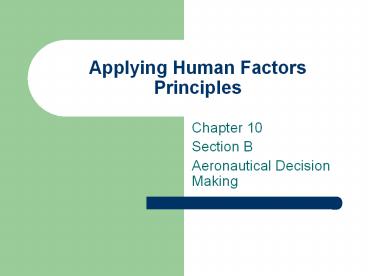Applying Human Factors Principles PowerPoint PPT Presentation
Title: Applying Human Factors Principles
1
Applying Human Factors Principles
- Chapter 10
- Section B
- Aeronautical Decision Making
2
Risk Elements
- Pilot fitness, competency, currency, experience
- Aircraft performance, limits, equipment,
airworthiness - Environment wx., airport conditions, ATC svcs.
- Operation purpose of flight
- Situation situational awareness of all above
3
Decision-making Process
- D detect
- E estimate
- C choose
- I identify
- D do
- E evaluate
4
Accidents Incidents
- Accident
- An occurrence in which any person on board the
aircraft suffers death or serious injury, or in
which the aircraft receives substantial damage - Incident
- An occurrence other than an accident which
affects the safety of operations
5
NTSB
- National Transportation Safety Board
- Investigates every U. S. civil aviation accident
- Issues safety recommendations
- Maintains database
- Conducts research on safety issues
- www.ntsb.gov
6
Poor Judgment Chain
- aka error chain
- Accidents and incidents rarely, if ever, are the
result of a single cause - Usually a series of errors occurs which lead to
the accident or incident - Break one link in the chain and sequence of
events would be stopped
7
Risk
- Flight activities where accidents are most likely
to occur
8
When do aviation accidents happen?
57.2 of GA accidents occur during 6 of flight
time Takeoff/initial climb, Approach, Landing
9
PIC Responsibility
- Read top half of page 10-28
- Judgment
- Learned
- From your mistakes
- From other experiences
- From the experiences of others
- Ability to exercise good judgment affected by
- Stressors
10
Stressors
- Three categories
- Physical stress
- Physiological stress
- Psychological stress
- Personal checklist
11
Stress
12
Improving Judgment
- Anticipate decisions
- Train and practice in critical areas
- Match individual skills with the job
- Standardize whenever possible
- Maintain positive attitudes
- Practice effective communications
- Be deliberate in decision making
13
Hazardous Attitudes
14
Communication
- Sending
- Listening
- Feedback
- Good ATC radio procedures help
15
Communication
- When the rear-seat pilot of a dual-piloted T-33
aircraft attempted to adjust his position, he
inadvertently deployed the life raft in the seat
bucket survival kit. As the raft inflated, it
pushed the stick forward, which caused the
aircraft to pitch nose down. The front seat
pilot attempted to correct the dive, but met
resistance when he pulled the stick back.
16
Communication, continued
- Meanwhile, the back seater found and deployed
the raft deflation tool. The front seater,
trying to solve the control problem, heard an
explosion as the cockpit filled with talcum
powder from inside the raft, which looked very
much like smoke. He identified the problem as an
engine failure, closed the throttle and secured
the engine.
17
Communication, continued
- As the haze cleared in the back, the back seater
noticed the apparent engine flameout and ejected.
The front seater then dead-sticked the aircraft
into a field. Throughout this entire sequence,
not a word was spoken.
18
Barriers to Sending
- Poor choice of words
- Silence
- Assumptions
- Tone
- Over load
- Volume
19
Barriers to Listening
- Boredom
- Complacency
- Distractions
- Impatience
- Anger
20
Feedback
- Ask for clarification until you understand
- Acknowledge
- Restate
- Confirm
- Observe
- Question
- Disagree
- Answer
21
Double Check When You Hear . . .
- Probably
- Possibly
- I think so
- I hope so
- Maybe
- Should
22
Internal Barriers to Communication
- Rank
- Attitude
- Choice of words
- Misinterpretation
- Hearback
- Hear what you want to hear or are expecting
- Mixing/switching numbers 200-220, 120,210
23
External Barriers to Communications
- High noise
- Uncomfortable temperatures
- High workload
- Uncertain of policies/procedures
- Unable to see the other person
24
Resources
- Internal in the cockpit during flight
- External outside of the cockpit during flight
25
Workload Management
- Plan
- Prepare
- Prioritize
26
Overload
27
Compare
28
Situational Awareness
- An accurate perception of the operational and
environmental factors which affect the aircraft,
pilot, and passengers during a specific period of
time. - Fixating on one thing
- Complacency
29
ADM Works!
- United Flight 232
- Captain Al Haynes
- We had 103 Years of flying experience in that
cockpit . . . but not one minute of that 103
years had been spent operating an airplane the
way we were trying to fly it. If we had not
worked together, with everybody coming up with
ideas and discussing what we should do next and
how we were going to do it, I do not think we
would have made it to Sioux City.

